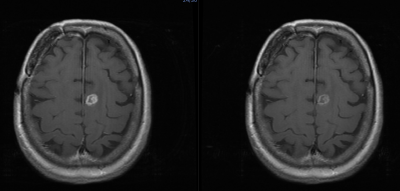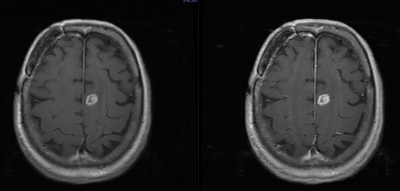1890
The efficacy of half dose gadolinium for contrast enhanced MRI of the brain using artificial intelligence algorithms and machine learning.1Radiology, University of Illinois College of Medicine, Peoria, IL, United States, 2A.I. Analysis, Inc., Seattle, WA, United States, 3Medical College of Wisconsin, Milwuakee, WI, United States, 4Radiology, Yale University, New Haven, CT, United States
Synopsis
The use of half dose gadolinium coupled with artificial intelligence algorithms is effective in visualizing primary and metastatic disease to the brain and reduces gadolinium retention concerns. There is potential cost savings from the use of lower dose gadolinium.
Introduction:
This study was performed to evaluate the utility of half dose gadolinium administration coupled with artificial intelligence algorithms in order to address concerns about gadolinium retention, reduce costs, and improve patient safety.Methods:
32 consecutive patients who had known or suspicious brain lesions were selected. All patients were scheduled to undergo contrast enhanced brain MRI, had an eGFR > 60 mL/min/1.73m2 and no known gadolinium sensitivities. The patients underwent unenhanced brain MRI on 1.5 Tesla or 3.0 Tesla scanners and then received 0.05 mmol/kg of gadobenate dimeglumine intravenously and a post-enhanced spin echo axial T1 weighted sequence was acquired. The patients then received a second dose of 0.05 mmol/kg of gadobenate dimeglumine for a cumulative full dose of 0.1 mmol/kg. A repeat spin echo axial T1 weighted sequence was acquired along with coronal and sagittal post-enhanced spin echo T1 weighted images. The half dose and cumulative full dose axial T1 weighted images were processed using genetic algorithms which employed intensity normalization, bias field correction, registration, segmentation and scaling. The processed images were compared by three blinded readers for a) overall image quality b) degree of enhancement and c) lesion count.Results:
Three blinded readers determined that, in all cases, the half dose synthetic images demonstrated equal or better quality enhancment than the full dose. The number of lesions did not change.Discussion:
Synthetic enhancement appears to be an effective tool to reduce concerns regarding gadolinium retention. Using a half dose of gadolinium may be especially important for vulnerable populations such as individuals who are pregnant, children and patients with renal insufficiency. In addition, those patients who receive frequent gadolinium enhanced MRI (patients with multiple sclerosis, women with a high risk of breast cancer) are likely to greatly reduce their lifetime accumulation of gadolinium by receiving half dose instead of full dose. Intra-operative MRI can be performed with two separate injections of half dose gadolinium in order to evaluate the throughness of neoplasm resection and the location of any residual tumor.Acknowledgements
noneReferences
1) Gong E, Pauly JM, Wintermark M, Zaharchuk G. Deep learning enables reduced gadolinium dose for contrast-enhanced brain MRI. JMRI: (48) 2
2) Kuhn MJ, Patriarche J, Patriarche D, Pirovano, Bona M. The Use of artificial intelligence to evaluate Differences contrast enhancement between tow macrocyclic gadolinium agents in patients with glioblastoma. RSNA 2019 oral presentation, December 2, 2019
3) Patriarche JW, Erickson BJ. Part 1. Automated change detection and characterization in serial MR studies of brain tumor patients. Journal of Digital Imaging. 2007: 20(3): 203-222
4) Patriarche JW, Erickson BJ. Part 2. Automated change detection and characterization applied to serial MR of brain tumors may detect progression earlier than human experts. Journal of Digital Imaging. 2007: 20(4): 321-328

